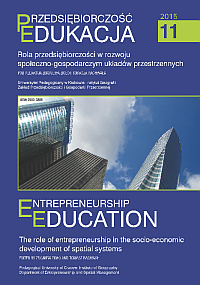Selected aspects of innovative companies within the clusters of the Swietokrzyskie Voivodeship
DOI:
https://doi.org/10.24917/20833296.11.19Keywords:
clusters, cooperation, innovativeness of enterprises, scientific environmentAbstract
The main objective of this article is to present various aspects involved in boosting innovation withincompanies located in clusters. Some factors taken into account are network links with various partners,the types of innovations implemented, and their sources, with an emphasis on cooperation withinthe scientific community. At the beginning of the article theoretical issues are discussed, relating tothe concept of clusters in the context of improving the innovativeness of enterprises. The empiricalportion of this article presents the level of innovation of the Swietokrzyskie region and resultsof companies located in clusters within the Swietokrzyskie Voivodeship. The basic research methodemployed was direct interviewing conducted by specialised interviewers. The study was carried outon enterprises located in clusters within the Swietokrzyskie Voivodeship. Study results demonstratedthat the cooperation of enterprises with entities, both economic and scientific, becomes increasinglyimportant and is reflected increasingly in the activities of companies located in the clusters examinedhere. One of the main sources of innovation in the researched enterprises is cooperation with otherentities and the wider scientific community.References
Berliński, L. (2003). Projektowanie i ocena strategii innowacyjnych: inżynieria strategii przedsiębiorstwa. Bydgoszcz: AJG Zakład Pracy Chronionej.
Drucker, P.F. (1998). On the Profession of Management. Boston: Harvard Business Scholl Press.
Etzkowitz, H. The Triple Helix: Industry. University, and Government in Innovation. Routledge.
Fagerberg, J., Mowery D.C., Nelson, R. (red.). (2005). The Oxford Handbook of Innovation. Oxford: Oxford University Press.
Fiedor, B. (1979). Teoria innowacji. Warszawa: PWN.
Florida, R. (1996). Toward the learning region. Futures, 27(5).
Francuz, P., Mackiewicz, R. (2006). Liczby nie wiedzą skąd pochodzą. Lublin: KUL.
Gorynia, M., Jankowska, B. (2008). Klastry a konkurencyjność i internacjonalizacja przedsiębiorstw Wielkopolski. Gospodarka Narodowa, 5–6, 91-109.
Hargadon, A., Sutton, R.I. (2000). Building Innovation Factory. Harvard Business Review, 78 (3).
Hildreth, P., Kimble, C. (2004). Knowledge Networks: Innovation Through Communities of Practice. London: Idea Group Publishing.
Maillat, D. (2002). Globalizacja, terytorialne systemy produkcyjne i środowiska innowacyjne. Rector’s Lectures. Kraków: Akademia Ekonomiczna.
Matusiak, K.B., Stawasz, E., Jewtuchowicz A. (red.). (2001). Zewnętrzne determinanty rozwoju innowacyjnych firm. Łódź: Wyd. Uniwersytetu Łódzkiego.
Porter, M.E. (2001). Porter o konkurencji. Warszawa: PWE.
Szulik, S. (red.). (2004). Klastry. Innowacyjne wyzwanie dla Polski. Gdańsk: Instytut Badań nad Gospodarką Rynkową.
Schumpeter, J.A. (1960). Teoria rozwoju gospodarczego. Warszawa: PWN.
European Trend Chart on Innovation. Thematic Report Cluster Policies, Covering Period up to March 2003, European Comission Enterpreise Directorate General.
Downloads
Published
How to Cite
Issue
Section
License
Articles are published under the terms of the Creative Commons License (CC BY-ND 4.0; Attribution– NoDerivs).

